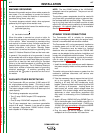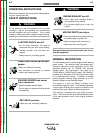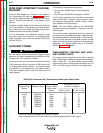
OPERATION
B-6 B-6
COMMANDER 400
Return to Section TOC Return to Section TOC Return to Section TOC Return to Section TOC
Return to Master TOC Return to Master TOC Return to Master TOC Return to Master TOC
4. ENGINE TEMPERATURE GAUGE AND LIGHT:
The gauge displays the engine oil temperature. The
yellow temperature light remains off under normal
operating temperatures. If the light turns on, the
engine protection system will shut down the engine.
Check for restrictions at the engine cooling air inlets
and outlets (consult the engine Operation manual).
Check for loose or disconnected leads at the tem-
perature sender located on the engine. Check
engine cooling blower belt. Also, check to be sure
that the welder loads are within the rating of the
welder. The light will remain on when the engine
has been shut down due to an over- temperature
condition.
5. OIL PRESSURE GAUGE AND LIGHT: The gauge
displays the engine oil pressure when the engine is
running. The yellow oil pressure light remains off
with proper oil pressure. If the light turns on, the
engine protection system will stop the engine.
Check for proper oil level and add oil if necessary.
Check for loose or disconnected leads at the oil
pressure sender located on the engine. The light
will go on and stay on when the RUN-STOP switch
is switched to the “RUN” position with the engine
not running.
6. ENGINE ALTERNATOR AMMETER AND LIGHT:
The yellow engine alternator light is off when the
battery charging system is functioning normally. If
the light turns on, the engine protection system will
shut down the engine. Check the engine cooling
blower belt. Also, the alternator or the voltage reg-
ulator may not be operating correctly. The light may
also come on if the alternator did not flash up due to
not holding the start button in long enough (mini-
mum of 2 seconds) or due to a faulty flashing circuit.
The light will remain on when the engine has been
shut down due to a fault in the alternator, regulator,
or the cooling blower belt.
7. IDLER SWITCH: Adjusts the running speed of the
engine. Has two positions as follows:
A) In the “High” position, the engine runs at the high
idle speed controlled by the governor.
B) In the “Auto” position, the idler operates as
follows:
a. When switched from “HIGH” to “AUTO” or
after starting the engine, the engine will
operate at full speed for approximately 15
seconds and then go to low idle speed.
b. When the electrode touches the work or
power is drawn for lights or tools (approxi-
mately 100 Watts minimum), the engine
accelerates and operates at full speed.
c. When welding ceases or the AC power load
is turned off, a fixed time delay of approxi-
mately 15 seconds starts.
d. If the welding or AC power load is not
restarted before the end of the time delay,
the idler reduces the engine speed to low
idle speed.
e. The engine will automatically return to high
idle speed when the welding load or AC
power load is reapplied.
Idler Operational Exceptions
When the WELDING TERMINALS switch is in the
“WELDING TERMINALS REMOTELY CONTROLLED”
position, the idler will operate as follows:
a. When the triggering device (Amptrol, Arc Start
Switch, etc.) is pressed, the engine will accelerate
and operate at full speed provided a welding load is
applied within approximately 15 seconds.
• If the triggering device remains pressed but no
welding load is applied, within approximately 15
seconds the engine will return to low idle speed.
• If the triggering device is released or welding
ceases, the engine will return to low idle speed
after approximately 15 seconds.
8. HOUR METER: The hour meter displays the total
time that the engine has been running. This meter
is a useful indicator for scheduling preventive main-
tenance.


















